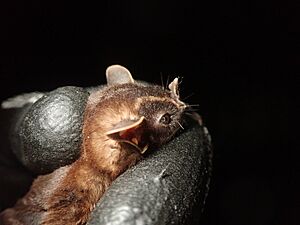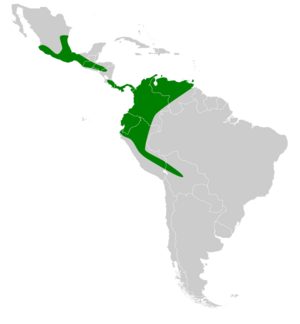Velvety fruit-eating bat facts for kids
Quick facts for kids Velvety fruit-eating bat |
|
|---|---|
 |
|
| In Puntarenas, Costa Rica | |
| Conservation status | |
| Scientific classification | |
| Genus: |
Enchisthenes
|
| Species: |
hartii
|
 |
|
| Synonyms | |
|
Artibeus hartii Thomas, 1892 |
|
The velvety fruit-eating bat (scientific name: Enchisthenes hartii) is also called Hart's little fruit bat. It is a type of bat that belongs to the family Phyllostomidae, which are often called leaf-nosed bats. This bat is special because it's the only species in its group, called a genus, named Enchisthenes. You can find these bats living in parts of Central America, Mexico, the United States, and northern South America.
Contents
About the Velvety Fruit-Eating Bat
These bats have fur that is almost black. They also have a few light-colored lines on their faces, but these lines are usually hard to see.
Size and Weight
The forearm of a velvety fruit-eating bat is about 36 to 41 millimeters long. That's about 1.4 to 1.6 inches. These bats are quite small, weighing about 14 to 18 grams. This is roughly the same weight as two to three quarters.
Bat Teeth
Like all mammals, bats have teeth! The velvety fruit-eating bat has a total of 32 teeth. This includes 2 teeth at the front, 1 canine tooth, 2 premolars, and 3 molars on each side of its upper and lower jaws.
Where Velvety Fruit-Eating Bats Live
This bat species lives in many countries. You can find them in Bolivia, Colombia, Costa Rica, Ecuador, El Salvador, Guatemala, Honduras, Mexico, Panama, Peru, Trinidad and Tobago, and Venezuela. There has also been one sighting of this bat in the state of Arizona in the United States.
How the Bat Got Its Name
The velvety fruit-eating bat was first described as a new species in 1892. A British scientist named Oldfield Thomas gave it the scientific name Artibeus hartii at that time. The "hartii" part of its name honors J. H. Hart. He was the person who gave the first bat specimen to Thomas for study. Mr. Hart was in charge of the Botanic Gardens in Trinidad, which is where this first bat was found.
Later, in 1908, another scientist named Knud Andersen decided this bat was unique enough to have its own group, or genus. He named this new genus Enchisthenes. So, the bat's full scientific name became Enchisthenes hartii.
Conservation Status
Scientists keep track of animal populations to make sure they are safe. As of 2008, the velvety fruit-eating bat is listed as a "least-concern species" by the IUCN. This means that its population is stable, and it is not currently at risk of disappearing.


